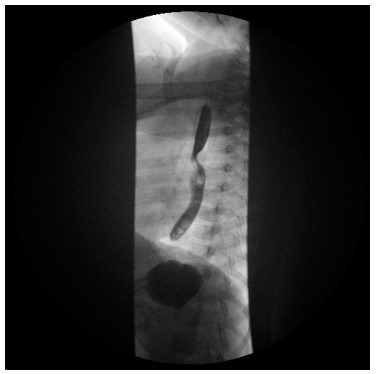Nocturnal Stridor and Noisy Breathing
Case
A two-year-old female presented to pulmonary clinic for two to three months of nocturnal stridor and snoring. She was born full term and had no history of recurrent respiratory infections or wheezing. She has had difficulty swallowing solids and thus was only drinking milk and eating pureed foods, with weight-for-age at the 25th percentile. Her stridor did not resolve with bronchodilator administration and only occurred during sleep. On exam, she was awake and comfortable without stridor. Her lungs were clear to auscultation with no pectus deformity. A chest radiograph was normal, and an overnight sleep study showed moderate obstructive sleep apnea (oAHI 8.9 events/hour with an oxygen nadir of 89%). An esophogram was performed (shown below).

Question
What is the diagnosis?
- Bronchomalacia
- Vascular Ring
- Asthma
- Croup
B. Vascular Ring
Discussion
Vascular rings are a result of congenital anomalies of the aortic arch or other large vascular structures which result in the compression of the tracheobronchial tree and/or of the esophagus. Vascular rings are classified as complete (involving both the trachea and esophagus) or incomplete (involving either the trachea or esophagus). The most common types of complete vascular rings are the double aortic arch and the right aortic arch. The child in this case was diagnosed with a right aortic arch, with posterior indentation of the esophagus by the aberrant left subclavian artery clearly visualized in the figure.
Children with vascular rings may present with variable symptoms such as wheezing outside of respiratory infections, noisy breathing, stridor, cough, or dyspnea. Physical examination may show signs of tachypnea, intercostal retractions, nasal flaring, or stridor. The diagnostic work-up typically begins with a chest radiograph to identify anatomic abnormalities, but compression of the trachea and/or esophagus may be difficult to identify. Further imaging may include a barium swallow or esophagram (can help identify both types of complete vascular rings), in addition to computed tomography (CT) with angiography for further evaluation of vascular structures. Treatment involves surgical correction. The surgical approach depends on the specific type of vascular ring. For this particular patient, the surgical approach was via a left thoracotomy and the ductus or ligamentum was identified and divided.
Bronchomalacia and croup do not present with dysphagia; while croup can present with nocturnal stridor, our child did not have the sudden onset and infectious symptoms typically occurring with this diagnosis (choices A and D are incorrect). Our patient did not respond to bronchodilator therapy, making asthma an unlikely the diagnosis (choice C is incorrect). Obstructive sleep apnea can be a comorbidity with asthma, airway malacia, croup, and vascular rings; while OSA may contribute to noisy breathing during sleep, it would not explain the dysphagia reported.
References
- Davies M, et al. Developmental abnormalities of the great vessels of the thorax and their embryological basis. Br J Radiol 2003; 76: 491.
- Licari A, et al. Congenital Vascular Rings: a clinical challenge for the pediatrician. Pediatr Pulmonol 2015; 50: 511.
- Fulton et al. Vascular Rings and Slings.



